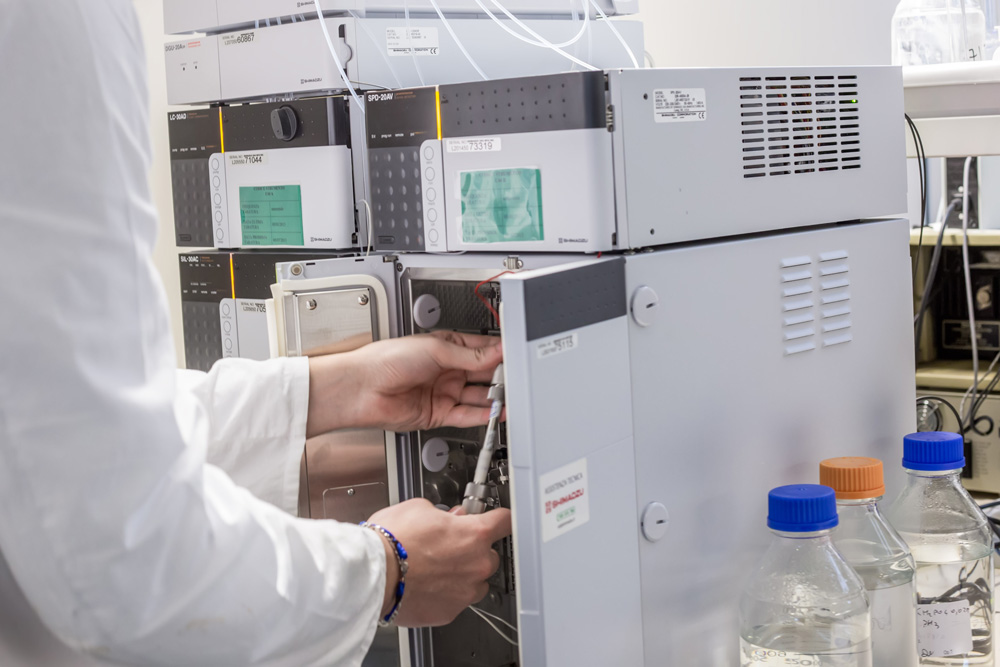The chemical and quality control laboratory at Abich performs tests on raw materials, cosmetic products, medical devices, materials in contact with food, toys, and other consumer products, in line with the Italian, European, and non-EEC countries regulations.
Abich develops tailored research protocols performing interdisciplinary tests like, for example, percutaneous absorption studies in line with the OECD guidelines or stability studies of cosmetic products, medical devices, or pharmaceuticals in line with ICH regulations.
The modern instruments allow to meet customers’ needs thanks to a wide range of validated tests.
Chemical analysis offered by Abich:
- Instrumental analysis: with HPLC and UHPLC with UV, DAD, RID, FLD detectors;
- Instrumental analysis: with GC-FID, GC-ECD, GC-MS, ICP-OES, FTIR-UATR, UV-VIS, GFAAS;
- Title of active principles;
- Analysis of multiresidal impurities and of trace contaminants in finished products and ingredients, like for example: phtalates, nitrosamines, VOC, substances listed in annex II of regulation (CE) 1223/2009.
- Analysis of multi-residual impurities: in finished products and raw materials, organic contaminants such as phthalates, pesticides, nitrosamines, and substances listed in Annex II of the EC Regulation n. 1223/2009;
- Ultratrace analysis: to support the claim “Paraben-Free”, identification of residual preservatives in production lines, “cleaning validation”, and finished cosmetic products;
- Identification of allergens: in finished products or raw materials of natural origin;
- Identification of aromatic amines: deriving from azo dyes;
- Metals: analysis of inorganic contaminants in finished products and raw materials: toxic metals like Hg, Cd, As, Pb and sensitising metals like Ni, Cd, Co, Cr. Cosmetic relevant metals: As, Sb, Cd, Hg, Ni, Co, Cr, Pb e Cr VI.
- Metals: ICH guideline Q3D (R2) on elemental impurities – Table 5.1: elements to be considered in the risk assessment – oral, parenteral and inhalation exposure.
- Release test in artificial sweat or saliva for the detection of sensitising metals in cosmetic anhydrous and solid products; Release test in artificial sweat or saliva according to ISO 10993-12 for substances or impurities in
medical devices. - Stability testing and accelerated stability testing: performed in climatic chambers, in line with the conditions prescribed by ICH and PCPC guidelines for chemical, chemico-physical and microbiological analysis;
- Dropping point testing: for lipsticks and waxes according to the European Pharmacopoeia method;
- Validation of analytical methods: in line with the ICH guidelines for medical devices and products for the European and North American market;
- Packaging compatibility testing: with products undergoing accelerated stability analysis, migration testing, leak testing, and analysis of the composition of plastic materials;
- Photostability testing on products with sunscreen: with SUN TEST CPS, title of sunscreens in UV and UHPLC/HPLC before and after irradiation;
- Chemical Analysis: on toys in line with the UNI EN 71 standard;
- Migration testing in artificial sweat: to evaluate the release of nickel and other sensitizing metals in products intended to come into direct and prolonged contact with the skin, in line with the UNI EN 1811 standard;
- Screening of plant extracts: development of an extraction method for scale-up of the manufacturing process;
- Safety and toxicity evaluation of e-cigarette: on finished products and raw materials components, flavourings, fragrances, while in use and not in use;
- Suitability of the materials in contact with food: under the Italian Ministerial Decree 21/03/73, the EC Regulation 1935/2004, and their subsequent amendments and supplements;
- Dynamometric measurement: of the adhesiveness of cosmetic depilatory waxes, depilatory strips, and depilatory plasters.
- Chemical characterization of medical devices according to ISO 10993-18: extractables and leachables
- “Nickel Tested”: control on product batches and intermediates bulks to support the claim “Nickel Tested
- Test and analysis to support “cleaning validation” processes.
- Percutaneous and permucosal absorption test through Franz cells (OECD 428 and FDA methods): many epithelial and epidermis human models as well as synthetic membranes.
- Stability assays according to ICH for medical devices, to CIPAC for PMC e Biocides, to ASTM or PCPC for cosmetics. Chemical-physical and microbiological analysis.
- Quality control: analysis of osmolarity, surface tension, viscosity, density, drop point, softening point etc. on ingredients, bulks and manufacturing product batches.
- Control of manufacturing for batches of PMC and Biocides.
- Photostability of sun products with SUN TEST – sunscreens analysis and evaluation of decay before and after Uv exposure.
- In vitro UVA pf and broad spectrum UV protection according to ISO 24443: and to Boots Star Rating; in vitro water resistance and variants.
- Mucoadhesion assay: adhesiveness test to verify and compare the physical adhesion properties of medical devices and products aimed to be used on mucosae.
- Compatibility with condoms according to ASTM D6771 o ISO 19671 standards through traction and explosion tests.
- Different variances of in vitro water resistantance (with salt water and clorinate water).
- In vitro evaluation of UVA long and blue light.
- Trichological tests in vitro on human hair locks to support customized cosmetic claims Test like for example: resistance to break, combability, color strenght and many others.
- Customized tests on hair treatments according to the sponsor’s needs.
- In vitro blue light protection and far UVA protection evaluations.
- UV protection test for Medical adhesive and Textiles according to EN 13758.









